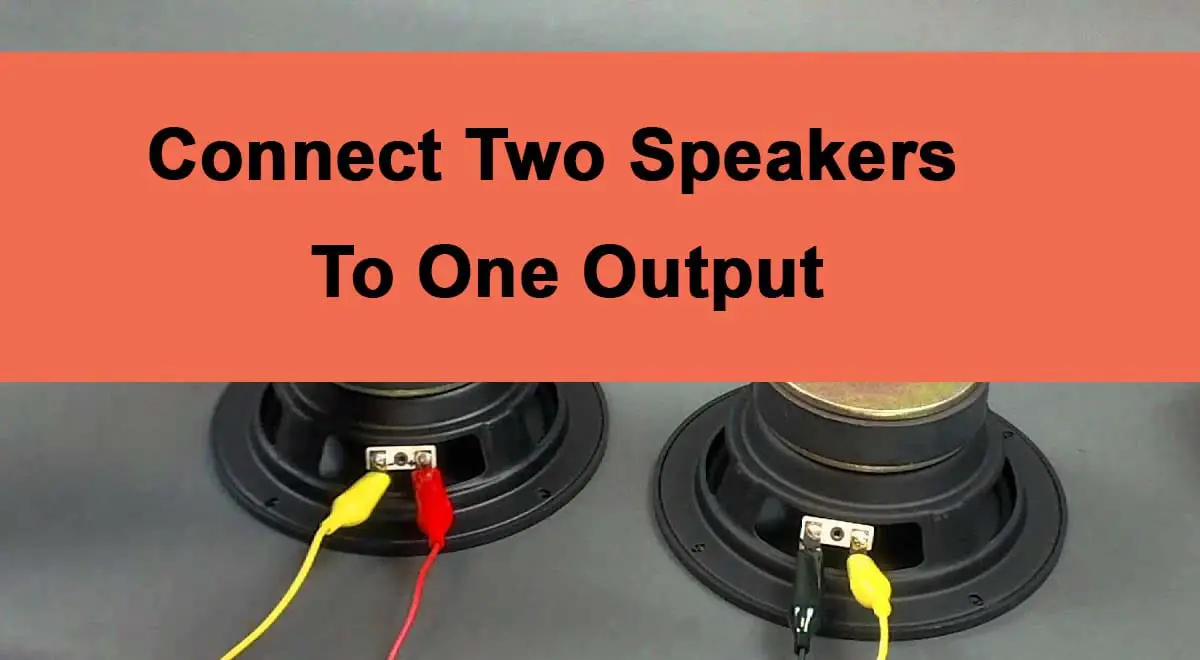Apparently, the idea of connecting two speakers to one output sounds impossible. But, nothing is impossible in this world. Because ‘Impossible’ even says “ I’m possible”. This article is a complete guide. By the end of this guide, you will learn to connect two speakers to one output.

Check Your Connection Feasibility First
You can connect two speakers to one output. But, that one output should be a regular amplifier.
You need to know the maximum current rating of the available amplifier. If your amplifier gives a higher current rating then it is ideal for connecting two speakers.
An amplifier giving a lower current rating will cause issues in audio performance and quality.
The ‘Parallel’ and ‘Series’ Connection
You can connect two speakers to one output source in two ways. One is the ‘parallel’ and the other is the ‘in series connection.
Before moving further, let’s have some idea of what these two types of connections mean.
The parallel connection flows current along different paths. In this type of connection, all the components are linked to each other’s leads.
The voltage difference on all the components of the circuit is different but the same in magnitude.
Simply speaking, the current will divide along with all the components and the sum total equals the main source.
The series connection means to link all the components in a line. The current from the source will flow through all the components of the series system.
All the components of the series circuit carry the same current. So, simplifying the concept, the current flows along a single path.
The speakers connected to this path receive their share. The best example of the series circuit is the Christmas tree lights.
But, this system has one disadvantage. If something happens to one part of the circuit, the entire circuit stops working.
Related: How To Connect 4 Speakers To 2 Channel Amp
Decide Between the ‘Parallel’ and ‘Series’ Connection
Now, your concepts are clear about the two types of connections. It is time to decide which one is best for you. All you need to check the impedance of your speakers. The impedance value is written on the back of the speakers or on their packaging boxes.
If you do not find impedance in any of these places, you can check it online. Most of the speaker brands post the specs of their products on their websites. Simply type the brand name of your speaker and search the required specs.
If your speakers are less than 8 ohms, it is recommended to make series connection with your amplifier. While if your speakers are more than 8 ohms, you can connect them in a parallel manner to your amplifier.
Connect two Speakers to One Output in Series
If you have two speakers, say 4 ohms each, they will add up to make 8 ohms. Most amplifiers support the load up to 6 or 8 ohms. So, in this case, the series connection is ideal. This connection decreases the total output power.
Let us understand the process of connecting two speakers to one source through series connection.
- Each speaker has two wires, take the wires from both speakers to join with the amplifier
- Insert the wire of one speaker into the positive terminal of the amplifier
- Insert the wire of the other speaker into the negative terminal of the amplifier
- Next, take the other two wires from each speaker and connect them together at their ends
- This would make a triangular shape
- If you want to connect the second speaker to the first one then follow some more steps.
- Cut one wire close to the 2nd speaker
- Link the 2nd speaker in series with the cut wire
- Connect both the speakers in series
- Now, connect them to the feed cable
This is how you can connect two speakers to one amplifier in series.
Related: Connect 6 Speakers To 2 Channel Amp
Connect two Speakers to One Output in Parallel
If you connect two 8 ohm speakers to one amplifier, the total load is 4 ohms. The total output power is increased in a parallel connection. So, your amplifier can support parallel connection easily and delivers good audio.
Let’s understand this process.
- In a parallel connection, the wires of both speakers are directly attached to the amplifier
- Take the positive wires of both speakers and join them to the positive terminal of the amplifier
- Now take the negative wires of both speakers and join them to the negative terminal of the amplifier
- Another way to make the parallel connection is to connect one speaker to the other
- You will connect the wires of one speaker to the 2nd speaker
- Now, connect both wires of the second speaker to the amplifier directly
- You need to connect in the same way; positive wire to the positive terminal of the amplifier and negative wire to the negative terminal of the speaker
Related: How To Wire 2 Channels To 1 Speaker
Advantages of Connecting two Speakers to One Output
There are the following benefits of connecting two speakers to one output;
- You can avoid separate volume control for each speaker
- Both speakers turn on/off at the same time. So, both speakers can be regulated simultaneously.
- It is also useful when you need to connect four speakers to one amplifier.
Hope you have understood the process of connecting two speakers to one output.
